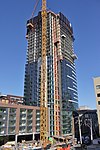Seattle Times Building

The Seattle Times Building is the former headquarters of The Seattle Times, located in Seattle, Washington, United States. The three-story building was occupied by the newspaper from 1931 to 2011, replacing the Times Square Building. It was originally built in 1931 and later expanded to accommodate more office space and larger presses. The exterior and roof of the Seattle Times Building were designated a city landmark in 1996. Designed by Robert C. Reamer with elements of the Art Deco and Moderne styles, the reinforced concrete building was representative of early 20th century architecture in Seattle. The newspaper moved out of the building in 2011 and sold it in 2013 to Onni Group, a Canadian real estate developer, who plans to build four residential skyscrapers on the site and adjacent parking lot to the south. Onni plans to preserve the building's facade and integrate it into the podium of a 240-foot-tall (73 m) building, converting it into a rooftop balcony. Demolition of the building began in October 2016, after incidents involving squatters on the property.
Excerpt from the Wikipedia article Seattle Times Building (License: CC BY-SA 3.0, Authors, Images).Seattle Times Building
Fairview Avenue North, Seattle Belltown
Geographical coordinates (GPS) Address Nearby Places Show on map
Geographical coordinates (GPS)
| Latitude | Longitude |
|---|---|
| N 47.620222222222 ° | E -122.33513888889 ° |
Address
Fairview Avenue North 215
98109 Seattle, Belltown
Washington, United States
Open on Google Maps








